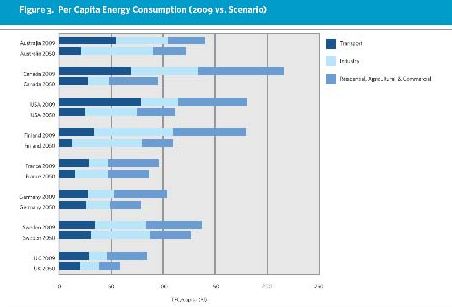Also discussed here: Low Carbon Energy Futures: A Review of National Scenarios (55 page pdf, Ralph D. Torrie, Tyler Bryant, Dale Marshall, Mitchell Beer, Blake Anderson, Ryan Kadowaki, and Johanne Whitmore, Technical Report, Trottier Energy Futures Project, Jan. 2013)
Today we review a report that compares low carbon future scenarios from 8 countries: 3 carbon resource rich (USA, Canada, Australia) and 5 European countries (Sweden Germany, France, Finland, UK). The common goal of the scenario was to lower carbon emissions by 80% from 1990 levels. Each country has its own approaches to the challenge from differing start points and so the scenarios differ as well although some similarities were noted including: decarbnization of the electricity supply, increased efficiency of fuels, a large supply of biofuels and electricity‘s share of the total energy consumption grows over time. Sweden has by far the lowest energy intensity because almost all of its electricity comes from nuclear, hydro and biomass- so that future reductions in carbon emissions comes from increased energy efficiency. Canada like Sweden also generates energy from non-carbon sources but has larger inputs ofnon-renewable energy sources (natural gas, coal, oil) in its energy pie and so has further to go to reach 80% less carbon emissions. Over 50% reductions in carbon emissions in Canada and the USA is in transportation where the growth of electric vehicles is key.

Key Quotes:
“the TEFP objective is to chart a course for an 80 per cent reduction in Canada’s energy-related GHG emissions by 2050, using 1990 levels as a baseline.”
"present scenarios of how Canada could make the transition to a sustainable, low-carbon energy (emissions 80% below current levels) future through increased efficiency, greater reliance on renewable and low-carbon fuels and electricity, and changes in the way we use energy.”
“Eight recent low-carbon energy scenarios were selected for review by the Trottier Energy Futures Project to inform its effort to identify and analyze such scenarios for Canada. The criteria for inclusion in the review were that the scenario analyses be national in scope, comprehensive (covering all energy end uses), quantitative, long-term (to the year 2050), and focussed on deep reductions in greenhouse gas emissions (80 per cent below current levels).”
“the search for an 80 per cent emission reduction pathway (the magnitude of the response required to avoid what many scientists refer to as dangerous climate change) requires a deeper, broader strategy for transforming the energy system. When we add to that objective the caveat that emission reductions must also satisfy the imperatives of sustainability, the effort becomes even more challenging, and even more transformative.”
“Five pillars of low carbon future:
- increased efficiency of fuel and electricity is paramount -- everything else depends on this,
- electricity's share of energy end use increases (but not to 100%, not in this century),
- the electricity supply is decarbonized,
- a large and sustainable supply of biofuels is needed to hit the stretch targets in this century, and
- we need to bend the baseline to achieve a lasting transition to a low carbon future.”
“Like Sweden, Canada generates a large share of its electricity supply from carbon-free sources, but Canada’s overall carbon intensity is still twice that of Sweden, reflecting much lower contributions from renewable sources and nuclear in the primary energy mix, as well as continued reliance on coal in some parts of the country.”
“In the context of what an 80 per cent reduction in emissions might look like, it is interesting to note that the emissions intensities of the European nations, whether measured on a per capita or per GDP basis, are already 40 to 75 per cent below Canada’s. And yet, as discussed below, the scenario analyses for those same European countries reveal the possibility of reducing those emissions by 80 per cent or more, implying emission intensities by 2050 that are 90 to 95 per cent below current Canadian levels.”
“Much higher levels of energy efficiency, greater electrification of end uses, decarbonization of the electricity supply, and increased use of biomass are key drivers in all the low-carbon scenarios.”
“In the Canadian scenario included in our inter-country comparison, final energy demand is 55 per cent below the reference or “business as usual” case, due to energy efficiency improvements across all end uses and sectors. Final demand for heat drops by 40 per cent relative to the business-as-usual outlook, and specific energy use of industry drops by 70 per cent. Transport energy intensity drops by 55 per cent, and the share of electricity in meeting the final demand for transport grows from almost zero today to about 50 per cent by 2050.”
“The Australian scenario is drawn from the oldest of the studies we reviewed, completed in 2002. Efficiency improvements reduce final demand for energy in the industrial sector by 45 per cent, and in the commercial buildings sector by 55 per cent (building design and envelope improvements; more efficient lighting, and heating, ventilating, and air conditioning systems and equipment).”
“The United States scenario uses the U.S. EIA 2010 annual energy outlook, which already contains significant energy efficiency gains in its baseline. Counting both the gains in the EIA Annual Outlook and the additional assumptions in the U.S. low-carbon scenario, automobile efficiency increases by more than 50 per cent.”







No comments:
Post a Comment